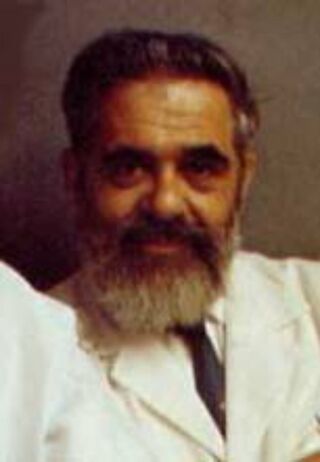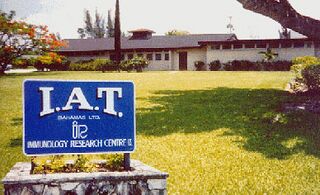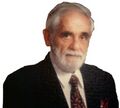|
|
| Zeile 21: |
Zeile 21: |
| | | | |
| | Aus diesen Eiweissen entwickelte er ein krebshemmendes Serum. | | Aus diesen Eiweissen entwickelte er ein krebshemmendes Serum. |
| − |
| |
| − |
| |
| − |
| |
| − |
| |
| − | Here’s how the serum came about. Tumor antibodies are alerted to the presence of tumor cells by a protein produced by the tumor cells called TCF, or Tumor Complement Factor, which induces the tumor antibodies to destroy the tumor cells. Since this can be done in an unregulated manner, the body produces BPF, or Blocking Protein Factors, to shield the tumor cells and regulate the rate of tumor kill. This balance is further regulated by DPF, or de-blocking protein factor, an alpha 2 macroglobulin that neutralizes the blocking protein and permits antibodies to destroy tumor cells in a regulated matter. However, this is a very balanced process and it can be upset by one or two or even all three factors getting out of hand, and when this occurs, the individual is said to be immuno-suppressive or immunodeficient. It is in this state that cancer advances uncontrolled.
| |
| − |
| |
| − | One did not need to measure TNF levels to determine the condition of a patients immune system, though TNF is a factor in the serum Burton created to shrink tumors.
| |
| − |
| |
| − | Since controlling a tumor’s growth was a matter of balance, Burton designed a computer program that could take a patient’s current blood condition and measure immune system function. This, however, was done in the day prior to micro computers and a huge system was required to make these calculations. Today, one could design a simple machine (not unlike those used by diabetics to read their levels) that could get a thorough reading in a matter of seconds.
| |
| − |
| |
| − | Once knowing how the system was imbalanced, Burton could design a serum using the four factors, plus TNF that would shrink the patient’s tumor. Again, it is important to know that he got the factors for his sera (plural of serum) from human blood: TCF is obtained from the serum of persons with cancer; DPF and tumor antibodies are obtained from serum of persons without cancer; the rest can be gotten from either.
| |
| − |
| |
| − | Dr Lawrence Burton developed a system that could shrink tumors in the early sixties, long before President Nixon began funding the War on Cancer.
| |
| − |
| |
| − | When he published, things got interesting.
| |
| − |
| |
| − | He suddenly found funding (The Damon Runyon Fund). The American Cancer Society sent him someone to work with him. The US Public Health Service begins picking up a few tabs. Over the next two years, Dr Burton’s research flourishes, expands, and progresses to the point where he’s able to destroy some tumors over night.
| |
| − |
| |
| − | Invited by the American Cancer Society to a national seminar of oncologists, Burton brings along cages of mice all with visible tumors. In front of the esteemed oncologists he injects the mice and the next day, they have no visible tumors.
| |
| − |
| |
| − | “Fraud,” some cried out.
| |
| − |
| |
| − | Burton offered them to bring in their own mice. He offered them the sera saying, “You inject them”
| |
| − |
| |
| − | No one took him up on his offer.
| |
| − |
| |
| − | Six months later, in 1966, again under the auspices of the American Cancer Society, Dr Burton appeared before the New York Academy of Sciences and performed a demonstration in front of 70 scientists and 200 science writers. He injected cancerous mice with his serum and in just 45 minutes, the mice’s tumors shrunk 50%. An hour and a half later the tumors had practically disappeared. Newspapers around the world ran the story on their front pages while the prestigious peer journals got their story from an investigator for Sloan-Kettering and Dr Castle from the American Cancer Society.
| |
| − |
| |
| − | Then came the contract negotiations. The big wigs, NCI, Sloan-Kettering, American Cancer Society wanted to buy it up from Burton. They’d give him grants and credit for it, but they wanted the rights.
| |
| − |
| |
| − | Burton turned them down.
| |
| − |
| |
| − | And overnight, Burton became the enemy.
| |
| − |
| |
| − | The funding stopped. Invitations to speak vanished. Publications refused to publish. The attacks began.
| |
| − |
| |
| − | Burton, nearly broke, had to stop his work. Instead he focused on opening a clinic to cure cancer. It took him a while, but in 1974 he opened a clinic in New York.
| |
| − |
| |
| − | Curing cancer in mice is one thing, but in humans it was much more difficult. Without his research funds, he was working in the dark. However, he was still able to realize a 50% success rate and received patients from physicians around the country. This was a remarkable rate considering that oncologists everywhere realized a success rate equal the success rate of patients with cancer who did nothing: 33%.
| |
| − |
| |
| − | Within two years, because of harassment from the FDA (that sordid mistress to moneyed interests), Dr Burton was forced to close his clinic and he left the United States of America to find freedom. (Ironic, eh?)
| |
| − |
| |
| − | Burton opened a clinic in Freeport, Commonweal of the Bahamas. The Immunology Research Centre, Ltd was a non profit corporation, licensed to treat patients diagnosed with cancer.
| |
| − |
| |
| − | The therapy was aptly named: IAT, or Immuno-Augmentative Therapy. According to Burton’s claims, IAT is an effective control for many forms of cancer because it restores natural immune defenses against cancer, but differs from immunotherapy, as generally defined, and is a two step procedure.
| |
| − |
| |
| − | Evaluation—measures “deficiencies” of the immune system.
| |
| − | Therapy—replenishes deficient factors (immunotherapy gives generalized stimulation to the immune system).
| |
| − | Daily therapy is prescribed specifically for each patient based on the most recent measurement of immune system function taken from blood tests daily, or twice daily depending on the patient.
| |
| − |
| |
| − | The readings from these tests are fed into a computer program developed by Dr. Burton, and therapy begins.
| |
| − |
| |
| − | There are no side effects. The treatment lasts 6 to 8 weeks, and the patient is sent home to work with their own doctors in hopes that the physicians will keep in contact with the centre in the Bahamas.
| |
| − |
| |
| − | The experience accumulated at the Immunology Research Centre has allowed them to publish a list of specific cancers and the odds of patient survival with those cancers using IAT. In other words, if you suffer from a particular cancer, all you have to do is call them and they will tell you accurately your odds of survival using IAT.
| |
| − |
| |
| − | Sadly, in the cancer industry, patients are often lied to by their oncologists who paint for them lovely pictures of success while knowing deep inside that the patient will, more often than not, dangle painfully from a noose that will eventually kill them while the oncologist looks on unable to save or even comfort them from the agony. [A quotation from an oncology nurse, a close friend, who recently died from breast cancer.]
| |
| − |
| |
| − | And here the story gets worse.
| |
| − |
| |
| − | We told you to remember that Burton’s sera came from human blood. Here’s why.
| |
| − |
| |
| − | In 1985, in a speech by the Deputy Director of the National Cancer Institute, it was mentioned as if in an aside, that Burton’s IAT specimens contained HIV.
| |
| − |
| |
| − | Supposedly two families returning from his clinic to the us had brought back 18 sealed IAT specimens. They were examined by a Washington State blood bank and all of them contained hepatitis B while some tested positive for HIV.
| |
| − |
| |
| − | Many feel that these tests were faked. Especially since the families who had brought them back into the US never contracted hepatitis B nor were they ever tested to be HIV+.
| |
| − |
| |
| − | The Bahamian Ministry of Health and Pan American Health Organization visited Burton’s clinic, and in July of 1985 the Bahamian Government closed the clinic. [http://cis.nci.nih.gov/fact/pdfdraft/9_unconv/fs9_15.pdf]
| |
| − |
| |
| − | Burton reopened his clinic in March of the following year, but in July, “the FDA issued an import ban prohibiting anyone from bringing IAT into the United States. This ban is still in effect. A sample of IAT frozen in a block of ice was offered to and analyzed by the FDA during the summer of 1987.” [http://cis.nci.nih.gov/fact/pdfdraft/9_unconv/fs9_15.pdf]
| |
| − |
| |
| − | The NCI’s publication goes on to state: “Although the sample was not sterile (free from contamination), there was no evidence of HIV or hepatitis B. Although Dr. Burton described his success in treating cancer patients in newspaper, magazine, and television interviews, several attempts to plan a clinical trial (research study with humans) in collaboration with Dr. Burton were unsuccessful. Dr. Burton died in 1993. The Immunology Researching Centre remains open under the direction of Dr. R. J. Clement.”
| |
| − |
| |
| − | The Centre under Burton treated over 4,500 patients, many arriving on their deathbed. His successes were many as were his failures. He boasted of a better than average (according to conventional medicine’s statistics) success rate, but refused to have his therapy tested. Considering that (as we have shown in numerous articles and newsletters) conventional medicine consistently forces their studies on alternatives to fail, we can understand Burton’s refusal.
| |
| − |
| |
| − | However, as Ralph Moss writes in his Cancer Chronicles [#18, 1993]: "If these claims [of therapeutic success] are false, then IAT is truly a delusion or fraud of monumental proportions. If they are true, however, then IAT is an astonishing discovery, with profound implications for the treatment of every cancer patient. Only good scientific studies can answer such a question."
| |
| − |
| |
| − | It’s funny, but modern medicine is a bit schizoid when it comes to their view of immunotherapies for cancer. Promulgated a long time ago by orthodox scientists, one of whom was awarded a Nobel Prize, today it is laughed at, most likely because the public understands it. Doctors hate when people stick their nose in doctor business.
| |
| − |
| |
| − | Yet on the other hand, immuno-stimulating factors such as interferon and interleukins are being lauded by the open press and prestigious peer publications alike, even though they have less than a 25% success rate.
| |
| − |
| |
| − | Burton was a pioneer. He was, like all pioneers, berated, abused, and cursed.
| |
| − |
| |
| − | His work today is being carried on by the fine people who ran the Aidan Clinic that we once reviewed, and today the Immunology Research Centre has a new name: Immuno-Technologies Cancer Clinic, and offers a wonderful combination of Burton’s therapies, those pioneered at the Aidan Clinic, and still others that are being tested at many clinics around the world (only you will NOT get a placebo at ITL (the nickname for Immuno-Technologies, Ltd)).
| |
| − |
| |
| − |
| |
| − |
| |
| − | Questioning Chemotherapy
| |
| − |
| |
| − | Second Edition of the International Wellness Directory - unavailable (but slated to be updated and republished))
| |
| − |
| |
| − | Speech by Gary Null, PhD, May 15, 1994 http://www.immunemedicine.com/paper1.asp
| |
| − |
| |
| − | http://www.immunemedicine.com/objectives.asp
| |
| − |
| |
| − |
| |
| | | | |
| | ==IAT in Deutschland== | | ==IAT in Deutschland== |
Die Immuno-Augmentative Therapie (IAT, immuno augmentative therapy) ist eine patentierte alternativmedizinisch-komplementärmedizinische Methode der Krebsbehandlung. Sie strebt eine Steigerung der Stärke des Immunsystems an. Ihr Nutzen in der Krebstherapie wurde jedoch nicht nachgewiesen. Vielmehr wird ihre Zweckmäßigkeit als negativ bewertet.[1][2].
Die IAT wird in einer eigenen IAT-Klink in Freeport (Grand Bahama) durchgeführt, der eine ITL-Klinik angeschlossen ist, die Heilung durch programmierte Eigenzellen, photodynamische Therapie und Krebsimpfstoffe verspricht.
Erfinder der Methode ist der amerikanische Zoologe Lawrence Burton, der 1977 die IAT-Klink in Freeport gründete, nachdem er die IAT in den USA nicht mehr anwenden wollte. Eine weitere IAT-Klink existiert in Mexiko (Immune Therapy Clinic in Playas).
Nach dem Tode Burtons im Jahre 1993 führte der englische Arzt John Clement die Klinik weiter. Burton entwickelte zuvor ein Verfahren zur extrakorporalen Behandlung von Blutzellen, die nach Behandlung zurücktransfundiert werden. Dieses ließ er sich patentieren. In den 1980er Jahren kam es bei mehreren seiner Patienten zu schweren Infektionen nach einer IAT.
Wissenschaftliche anerkannte Veröffentlichungen oder Studien, die den Nutzen des IAT-Verfahrens positiv bewerten, existieren nicht.
Erfinder Lawrence Burton
Lawrence Burton studierte Biologie an der New Yorker Universität und promovierte 1955. Obwohl Zoologe, interessierten ihn Krebserkrankungen. Er ist Autor mehrerer wissenschaftlicher Fachartikel. Er entdeckte IgA, IgG, und IgM - Immunglobuline, denen er eine krebshemmende Wirkung beimass. Er bezeichnete sie als
- Immunoglobulin2
- Tumor Complement Factor
- Blocking Protein Factor
- De-blocking Protein Factor
Ihm wird auch die Entdeckung des [TNF/TNFR-Superfamilie Tumor Necrosis Factor TNF] zugesprochen.
Aus diesen Eiweissen entwickelte er ein krebshemmendes Serum.
IAT in Deutschland
In Deutschland wurde im Herbst 1987 vom Frankfurter Kaufmann Rolf Bareuter in Gelsenkirchen eine Tagesklinik für Immuno-augmentative Therapie (IAT) unter Mitwirkung einer Gesellschaft für Immuntherapie (GIT) gegründet. Die Klinik soll einen jährlichen Umsatz von 9-10 Millionen DM gehabt haben. Ärztlicher Leiter war ein Klaus Morkramer. In dieser IAT-Klink wurden Kranke aller Krebsarten behandelt. Eine sechswöchige Erstbehandlung kostete DM 18.250 ohne Unterbringungskosten. Eine zweijährige Behandlung soll 60.000 DM gekostet haben.[3]
weitere Bilder
Literatur
- Green S.: Immunoaugmentative therapy. An unproven cancer treatment JAMA 270:1719-1723, 1993
- Questionable methods of cancer management. Immuno-augmentative therapy (IAT) CA Cancer J Clin. 1991 Nov-Dec;41(6):357-64
- Curt GA, Katterhagen G, Mahaney F.: Immunoaugmentative therapy. A primer on the perils of unproved treatments JAMA 255:505-507, 1986.
- Urteil BSG 1 Rk 28/95, Sozr 3-2500 §135 No. 4.; BSG Az 1 Rk 17/95; 1 Rk 14/96; 1 Rk 30/95; 1 Rk 32/95 vom 16. September 1997
- Barrett S, Cassileth BR, editors: Dubious cancer treatment. Tampa, Florida: American Cancer Society, Florida Division, 1991:63-71.
- Unproven methods of cancer management: immuno-augmentative therapy. CA: a Cancer Journal for Clinicians 1984;34(4):232-237.
- Curt GA. Warning on immunoaugmentative therapy (letter). N Engl J Med 1984;311(13):859.
- MMWR (Anonymous). Cutaneous nocardiosis in cancer patients receiving immunotherapy injections - Bahamas. MMWR 1984;33:471-472,477.
Weblinks
Quellenangaben



